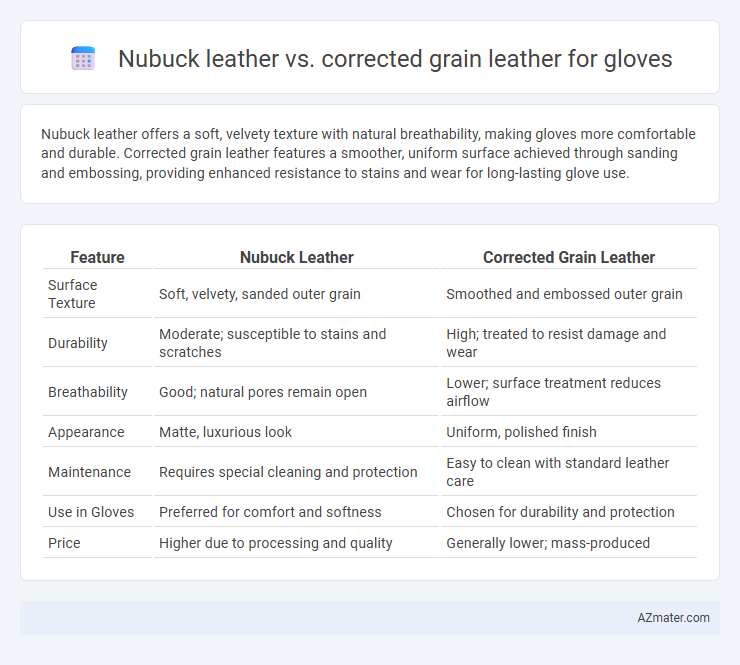Nubuck leather offers a soft, velvety texture with natural breathability, making gloves more comfortable and durable. Corrected grain leather features a smoother, uniform surface achieved through sanding and embossing, providing enhanced resistance to stains and wear for long-lasting glove use.
Table of Comparison
| Feature | Nubuck Leather | Corrected Grain Leather |
|---|---|---|
| Surface Texture | Soft, velvety, sanded outer grain | Smoothed and embossed outer grain |
| Durability | Moderate; susceptible to stains and scratches | High; treated to resist damage and wear |
| Breathability | Good; natural pores remain open | Lower; surface treatment reduces airflow |
| Appearance | Matte, luxurious look | Uniform, polished finish |
| Maintenance | Requires special cleaning and protection | Easy to clean with standard leather care |
| Use in Gloves | Preferred for comfort and softness | Chosen for durability and protection |
| Price | Higher due to processing and quality | Generally lower; mass-produced |
Introduction to Nubuck Leather and Corrected Grain Leather
Nubuck leather is a top-grain leather that is sanded or buffed on the outer side to create a soft, velvety surface, offering a luxurious feel and natural breathability ideal for high-quality gloves. Corrected grain leather undergoes surface treatment where imperfections are sanded away, and an artificial grain is embossed, resulting in a more uniform appearance with enhanced durability and stain resistance. Choosing between nubuck and corrected grain leather depends on preferences for texture, aesthetic appeal, and the glove's intended use.
How Nubuck Leather Is Made
Nubuck leather is made by sanding the outer layer of full-grain cowhide to create a soft, velvety surface with a fine nap, offering both durability and breathability for gloves. This process preserves the leather's natural strength while providing a luxurious feel, making nubuck gloves highly resistant to wear and tear. In contrast, corrected grain leather undergoes buffing and embossing to mask imperfections on lower-quality hides, resulting in a less natural texture and reduced breathability.
The Manufacturing Process of Corrected Grain Leather
Corrected grain leather for gloves undergoes a rigorous manufacturing process that starts with splitting lower-grade hides, followed by sanding or buffing the surface to remove imperfections. This surface is then stamped with an artificial grain pattern and coated with pigments or finishes to enhance durability and uniform appearance. The resulting leather is more resistant to stains and wear but typically less breathable than natural nubuck leather, making the manufacturing process critical for balancing aesthetics with functionality.
Key Differences Between Nubuck and Corrected Grain Leather
Nubuck leather has a soft, velvety texture achieved by sanding the outer layer of the hide, offering a premium feel and increased breathability, while corrected grain leather is sanded and embossed to remove imperfections, resulting in a more uniform and durable surface. Nubuck's natural texture requires gentle care to avoid stains and water damage, whereas corrected grain leather is more resistant to wear and easier to maintain. For gloves, nubuck provides a luxurious, flexible fit ideal for casual use, and corrected grain leather delivers toughness and longevity suitable for heavy-duty or industrial applications.
Durability Comparison for Gloves
Nubuck leather, made from the outer side of a hide with a top-grain buffed finish, offers a soft texture but is less resistant to abrasion and moisture, impacting glove durability under heavy use. Corrected grain leather undergoes surface sanding and coating, providing enhanced resistance to wear, stains, and moisture, resulting in longer-lasting gloves suitable for rugged tasks. For gloves requiring maximum durability and protection, corrected grain leather outperforms nubuck in maintaining integrity over time.
Comfort and Flexibility: Nubuck vs Corrected Grain
Nubuck leather offers superior comfort and flexibility for gloves due to its soft, suede-like texture and natural breathability, making it ideal for prolonged wear and dexterous movements. Corrected grain leather, while more durable and resistant to stains, tends to be stiffer and less pliable, which may reduce comfort and flexibility in gloves. For applications requiring enhanced tactile sensitivity and comfort, nubuck leather outperforms corrected grain leather in terms of softness and flexibility.
Appearance and Aesthetic Appeal in Gloves
Nubuck leather offers a soft, velvety texture with a matte finish, giving gloves a luxurious and sophisticated appearance that highlights natural grain patterns subtly. Corrected grain leather features a smooth, uniform surface with an embossed grain pattern, providing a polished and consistent aesthetic suitable for a more formal or utilitarian look. The choice between nubuck and corrected grain leather significantly impacts the glove's visual appeal, balancing natural elegance against durability and blemish concealment.
Maintenance and Cleaning Tips
Nubuck leather gloves require gentle cleaning with a soft brush or specialized nubuck cleaner to maintain their velvety texture, avoiding water and harsh chemicals that can damage the surface. Corrected grain leather gloves offer easier maintenance, as their durable, coated surface resists stains and can be cleaned with mild soap and a damp cloth. Regular conditioning of both types with suitable leather conditioners prevents drying and cracking, extending glove longevity and preserving flexibility.
Cost Considerations for Glove Buyers
Nubuck leather gloves generally carry a higher price tag due to the meticulous sanding process that produces a soft, velvety texture, enhancing comfort and breathability. Corrected grain leather gloves are more cost-effective because they utilize lower-grade hides with a stamped or embossed surface, allowing mass production at a lower cost. Glove buyers seeking durability at a budget-friendly price often prefer corrected grain leather, while those prioritizing luxury and softness invest more in nubuck options.
Which Leather Is Best for Gloves?
Nubuck leather is best for gloves requiring a soft, velvety texture and high breathability, offering excellent comfort and flexibility for extended wear. Corrected grain leather provides enhanced durability and resistance to abrasion with a smoother, more uniform surface due to its buffed and coated finish, ideal for heavy-duty glove applications. Choosing between the two depends on whether the priority is suppleness and tactile sensitivity (nubuck) or rugged protection and longevity (corrected grain).

Infographic: Nubuck leather vs Corrected grain leather for Glove
 azmater.com
azmater.com